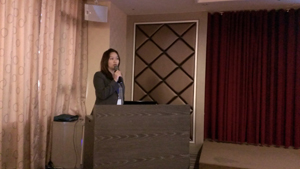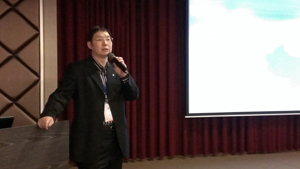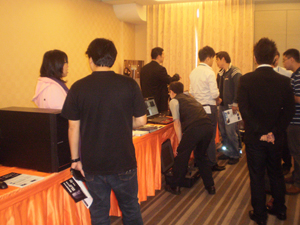2013 Metalworking Technology Legacy and Innovation Seminar
Leadhope Int'l and MIRDC hold event backed by expert presentations
2013/09/04 | By Steve Chuang
To offer local operators insight into ongoing trends in the global metalworking industries, Leadhope International Inc., a CAM (computer aided manufacturing) solution provider, held the “2013 Metalworking Technology Legacy and Innovation Seminar” in association with the MIRDC late April in Taichung, central Taiwan. A couple of industry experts presented solutions using information technologies to solve common problems in casting and stamping to enhance output quality.
Trends in R&D Technologies
J.Y. Leung, president of C3P Engineering Software International (HK) Co., Ltd., a developer of expert systems and design software for casting, talked about trends in R&D technologies in new product development.
Leung began by discussing auto development, saying that engineers relied on hand drawing, slide rules and knowledge of descriptive geometry and curves to find ideal methods of car-making. Vehicle development was mainly hardware-based so it was very slow and costly, taking 24 to 36 months to develop a new model.
Today with metalworking technologies as molding, casting, stamping and welding for car-making continuously advancing alongside IT, carmakers can develop new models using virtual technologies to shorten manufacturing time, lower cost and ramp up output, also achieving more complex designs with lighter mass. So current vehicle development is virtual, synthetic and simulation-backed, says Leung. So a new model now takes no longer than 18 months to hit showrooms due to IT-enabled design.
According to Leung, development of new products is moving forward to emphasize more on design for manufacturability (DFM) to shorten design-to-manufacture cycle and reduce processing difficulties, so “upfront design” and “upfront technologies” are increasingly important and relevant to larger, global enterprises.
Leung went on to say that upfront design is also a growing trend among casting manufacturers, which can be simply regarded as design based on operators' engineering experiences. One example is that experienced engineers can optimize casting structure with additional geometric design to offset predicted deformation.
With upfront design, Leung says that in metalworking technique development, design guidelines and standards are entirely systemized rather than merely shown in Excel files, with design process always systematic, intelligently controlled rather than being arbitrary; while successful engineering experiences and accumulated know-how are incorporated in design to enhance design quality to also shorten analysis and reworking.

Expert Systems Needed
To that end, Leung says that casting makers have to take advantage of expert systems, which incorporate CAD (computer aided design), CAE (computer aided engineering) CAM and databases of different process variables that are found from real-world experiences and practices, so that they can help with total solutions, from analysis and design of gating systems, liquid velocity, casting zones, gate-runners, ingates, sprues, cooling and venting to 3D graphic production and various simulations, to efficiently, effectively produce castings with minimum defect, like gas, shrinkage porosity, geometric deformations, etc.
As most Taiwanese casting makers can't afford expert systems, they use only CAD software. CAD software can't provide users needed process parameters and available options of gating system designs to optimize upfront designs for casting and molding as expert systems, says Leung.
With development of new products being increasingly required to be faster with higher quality achieved, innovation is actually key to satisfying demanding customers nowadays. But Leung says that innovation is not only about using new applied technologies, but can be gleaned from fully developed theories, decades-long engineering experience, successful designs and know-how to pass down to younger generations, which is the savvy way to facilitate upfront design and upfront analysis.
CAM for Casting
Leadhope's project manager, Y.C. Huang, presented the topic “Casting Design Innovation and Legacy,” introducing the status of Taiwan's casting industry.
With some 15,000 workers, the industry generates output of around NT$84 billion annually, and greatly influences downstream sectors with overall output value exceeding NT$1 trillion. But as other traditional manufacturing sectors, the industry is hindered from growing by insiders' lack of ability to expand distribution network globally due to being small and medium in size; overdependence on built-to-order manufacturing to result in poor capability to upgrade product; and shortage of local young workers due to working conditions typically viewed as dangerous, dirty and demeaning, according to Huang.

Also to cope with global competition, the industry has to overcome excessive supply, underselling and especially customers' demand for shorter lead time, more sophisticated design and complex specifications, as well as higher levels of applied technologies. To take on such challenges, Huang says that applying CAM in casting is critical.
Using CAM can assure casting makers speedy, optimal simulations to improve wrong gating system design that may cause defect after solidification, also helping to speed up new product development, enhance precision of molds and reduce rework, subsequent processing and tryouts. “Our experiences show that our CAM software enables users to boost efficiency and quality of gravity die casting, high pressure die casting,” says Huang.
Also, using CAM, she adds, enables operators to gradually build in-house databases of process values found in production and simulation analysis on computers, which can be passed down to young workers to ensure sustainable development. “We believe CAM can help casting makers strengthen R&D capability, knowledge management and production efficiency, which are global trends.”
Other Topics
T.Y. Chou, chairman of e-Card Tech, a Taiwanese franchised agent of CAD, CAM, CAE and PDM software from France's Dassaault Systems, Germany's T-Systems and the Britain's Vero, introduced his company's total solutions successfully applied in the stamping sector.
Chou says that the total solution incorporates CAD, CATIA Solution and VISI Solution coupled with Form-Advisor Solution.

The CATIA solution features a database of standardized and customized parts and simulations of motion mechanisms, allowing stamping makers to effectively build product details and design mold structure in 3D graphics that suit development of larger sheet metal and stage dies. Functionally similar with CATIA, the VISI solution is specifically for small and medium-sized sheet metal and progressive dies. The Form-Advisor is used for formability analysis, which can help operators to minimize stamping deformation and other common defects, says Chou.
MIRDC MII (Metal Industry Intelligence) sent a representative to briefly update the audience on Taiwan's metal material and metal product industries, as well as MII's forecast of trends in the mold and die sector.
The metal material sector's output value grew from NT$830 billion in 2003 to NT$1.6 trillion in 2012 at a 10-year compound annual growth rate (CAGR) of 7.3%, with companies numbering 73,847, 37% in northern Taiwan, 24% in the central and the remainder in the south. The metal product industry finished last year with output of NT$704.6 billion, representing a CAGR of 4.0% compared to NT$486.9 billion in 2002, says the representative.
As to MII's observation of the global die and mold industry, the representative says that molds and dies with high precision, market niches, long lifespan and low production cost have become global trends. With global manufacturing concentrated in emerging countries, Asia has become the world's major market for molds and dies, especially Southeast Asia.
The MII forecasts that the industry in Taiwan, undermined by underselling rivals from China and Korea and lacking R&D momentum to sharpen competitiveness, is likely to maintain output value of NT$50 billion in the next decade, provided the government comes up with savvy support policies or the output value may decline to around NT$40 billion.




